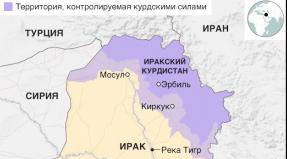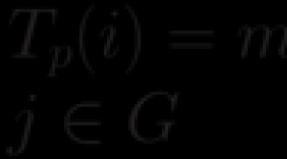The procedure for maintaining accounting of financial results. Accounting for financial results Accounting for income and financial results in the enterprise
The financial result of the economic activity of the enterprise is determined by the indicator of profit or loss formed during the calendar (economic) year.
The financial result is the difference between the amounts of income and expenses of the company. The excess of income over expenses means an increase in the property of the enterprise - profit, and the excess of expenses over income means a loss. The financial result obtained by the company for the reporting year in the form of profit or loss, respectively, leads to an increase or decrease in the company's equity capital.
The accounting regulations “Income of the organization” (PBU 9/99) and “Expenses of the organization” (PBU 10/99), approved by Orders of the Ministry of Finance of Russia dated 06.05.1999 No. 32n and No. 33n, respectively (with amendments and additions), recognize an increase in income , and expenses - a decrease in economic benefits as a result of the receipt or disposal of assets, as well as the extinguishment or occurrence of liabilities, leading to corresponding changes in the capital of the enterprise. The specified normative acts provide a grouping of income and expenses to reflect them in accounting and reporting, give their definition and the procedure for recognition in accounting.
According to PBU 10/99 (clause 16), expenses are recognized in accounting if the following conditions are met:
The expense is made in accordance with a specific contract, the requirement of legislative and regulatory acts, business customs;
The amount of expense can be determined;
There is confidence that as a result of a particular transaction there will be a decrease in the economic benefits of the organization. There is assurance that a particular transaction will result in a decrease in the economic benefits of the entity when the entity has transferred the asset, or there is no uncertainty about the transfer of the asset.
If in respect of any expenses incurred by the organization, at least one of the above conditions has not been fulfilled, then the accounts receivable are recognized in the accounting of the organization.
Depreciation is recognized as an expense based on the depreciation charge based on the value of the assets being depreciated, useful lives and the way the entity is accrued for depreciation.
Expenses are subject to recognition in accounting, regardless of the intention to receive revenue, operating or other income and from the form of the expense (cash, in-kind and other).
Expenses are recognized in the reporting period in which they occurred, regardless of the time of actual payment of funds and other form of implementation (assumption of temporary certainty of the facts of economic activity).
Expenses are recognized in the income statement:
Taking into account the relationship between the expenses incurred and receipts (correspondence of income and expenses);
By reasonably distributing them between reporting periods, when expenses determine the receipt of income over several reporting periods and when the relationship between income and expenses cannot be clearly determined or is determined indirectly;
For expenses recognized in the reporting period, when it becomes certain that they do not receive economic benefits (income) or receive assets;
Regardless of how they are taken for the purposes of calculating the taxable base;
When liabilities arise that are not contingent upon the recognition of the related assets.
According to PBU 9/99, expenses from ordinary activities are revenue from the sale of products and goods, receipts associated with the performance of work, the provision of services (hereinafter referred to as revenue).
Revenue is recognized in accounting if the following conditions are met (clause 12 of PBU 9/99):
a) the organization has the right to receive this proceeds arising from a specific contract or otherwise confirmed in an appropriate way;
b) the amount of revenue can be determined;
c) there is confidence that as a result of a particular operation, there will be an increase in the economic benefits of the organization. The assurance that as a result of a particular transaction there will be an increase in the economic benefits of the organization exists in the case when the organization received an asset in payment or there is no uncertainty about the receipt of the asset;
d) the right of ownership (possession, use and disposal) to the product (goods) has passed from the organization to the buyer or the work is accepted by the customer (the service is provided);
e) the costs that will be incurred or will be incurred in connection with this operation can be determined.
If in respect of monetary funds and other assets received by the organization in payment, at least one of the above conditions has not been fulfilled, then the accounts payable, and not the proceeds, are recognized in the accounting of the organization.
An organization may recognize in accounting revenue from the performance of work, the provision of services, the sale of products with a long production cycle as soon as the work, service, product is ready or upon completion of the work, the provision of the service, or the manufacture of products in general.
Revenue from the performance of a specific work, the provision of a specific service, the sale of a specific product is recognized in accounting as soon as it is ready, if it is possible to determine the readiness of the work, service, product.
With respect to different in nature and conditions of performance of work, provision of services, manufacture of products, an organization may simultaneously apply different methods of revenue recognition in one reporting period, provided for in clause 13 of PBU 9/99.
If the amount of proceeds from the sale of products, the performance of work, the provision of services cannot be determined, then it is accepted for accounting in the amount of the recognized costs in accounting for the manufacture of these products, the performance of this work, the provision of this service, which will subsequently be reimbursed to the organization.
The financial result of the economic activity of an enterprise is formed from two of its components, the main of which is the result obtained from the sale of products, goods, works and services, as well as from business transactions that are the subject of the enterprise, such as the lease of fixed assets, transfer in the paid use of intellectual property objects and investment in the authorized capital of other enterprises.
The second part in the form of income and expenses not directly related to the formation of the main realized financial result (financial result from sales), forms other financial result, including operating and non-operating income and expenses. If during the reporting period the enterprise made a profit from the sale of products, goods, works, services and other operations that constitute the subject of its activity, then its entire financial result will be equal to the profit from sales plus other income minus other expenses. If the organization receives a loss on sales, then its total financial result will be equal to the sum of the loss on sales plus other expenses minus other income.
The overall financial result obtained in this way is adjusted for the amount of losses, expenses and income in connection with the extraordinary circumstances of the economic activity of the enterprise.
The realized financial result is determined at the end of each reporting period. If the financial result is profit, then it is reflected in the credit of account 99 "Profits and losses" in correspondence with the debit of account 90 "Sales". If the result of the company's activities is a loss, then it is reflected in the debit of account 99 "Profits and losses" in correspondence with the credit of account 90 "Sales".
Other income and expenses included in the overall financial result of the organization are reflected in accounting separately from the financial result from sales on account 91 "Other income and expenses" by means of a "detailed" reflection of certain items of income and expenses during the reporting period.
In the financial statements of profit and loss, income can be shown net of the corresponding expenses related to these income, in cases where this is provided or not prohibited by accounting rules or if individual items of income and related similar items of expenses are not material for the characteristic financial position of the organization.
Other income is reflected in the credit of account 91 "Other income and expenses" in correspondence with the debit of accounts for the accounting of funds, settlements, inventories and other relevant accounts.
Analytical accounting for account 91 "Other income and expenses" is kept for each type of other income and expenses. At the same time, the construction of analytical accounting for other income and expenses related to the same financial or business transaction should ensure the ability to identify the financial result for each transaction.
It should be borne in mind that entries on accounts 90 and 91 are made on an accumulative basis from the beginning of the reporting year so as to ensure the formation of the necessary information for drawing up a profit and loss statement (Form No. 2).
The balanced result of account 91 "Other income and expenses" in the form of profit and loss is monthly written off, like the balance of account 90 "Sales", to the final accumulative account of financial results 99 "Profits and losses": the balance in the form of profit - to the credit of account 99 s the debit of account 91, the balance in the form of losses - to the debit of account 99 from the credit of account 91.
Extraordinary income and expenses are reflected directly on account 91 "Other income and expenses": income - on credit, expenses - on debit in correspondence with the corresponding accounts for accounting for monetary funds, inventories, settlements, etc.
On account 99, at the end of the first quarter, the interim financial result for the first quarter is revealed, at the end of the second quarter - for the first half of the year, at the end of the third quarter - for 9 months of the year and at the end of the fourth quarter - the final financial result for the entire reporting period.
The information structure of account 99 "Profits and losses" for the formation of the final financial result must ensure the receipt of:
1) systematic reliable information on accounting profit - an indicator necessary to determine the taxable base for income tax by making appropriate tax adjustments to accounting profit;
2) information on the formation of the final indicator of net retained earnings that comes to the disposal of the founders (participants) of the enterprise for distribution at the end of the economic and financial year and is transferred in December of the reporting year to account 84 "Retained earnings (uncovered loss)".
In the system of accounts, reflecting the financial results of the enterprise for the reporting year, all the necessary information about the indicators contained in the financial statements of profit and loss (Form No. 2) must be formed.
Analytical data on all accounts of this group participate as turnovers and balances in the formation of indicators of the profit and loss statement for the reporting year.
At the end of the calendar year, the final calculation of the amount of income tax due to the budget at the established tax rate is made, as a matter of priority, from the amount of the actual accounting profit received by the company for the reporting year. In this case, the amount of taxable profit differs from the accounting profit of the enterprise by the amount of those positive and negative adjustments that are established by the Tax Code of the Russian Federation on taxation of profit.
A complete list of all adjustments to the reported profit to the taxable level is given in the form of a certificate attached to the tax declaration for calculating tax from actual profit.
Due to the fact that the profit indicator in the current quarterly reporting does not represent the final financial result, the current payments of income tax calculated on a quarterly basis, as well as intra-quarter payments, are of an advance nature. This current (in fact, advance) distribution of profits is now reflected during the year on the debit of account 99 "Profits and losses" in correspondence with the credit of account 68 "Calculations of taxes and fees".
The amount remaining after deducting the tax accrued from the profit is called net profit, which does not correspond to international accounting practice. In foreign literature, this term has a different meaning, it means the balanced result of comparing all the income and expenses of the enterprise, i.e. the entire financial result.
With the convergence of Russian accounting practice with international accounting and reporting standards, the concept of net profit as remaining at the disposal of the enterprise practically ceased to exist. Its place was taken by a new concept - “retained earnings of the reporting year”. This part of the profit is now managed by the enterprise after the completion of the process of its formation. From the net profit, the enterprise (both before and now) reimburses payments under the sanctions of the relevant authorities for non-compliance with tax rules and the payment of similar mandatory payments to social state extra-budgetary funds (pension fund, social and health insurance funds).
These expenses are reflected in accounting as they are accrued by a record:
Debit account 99 "Profit and loss"
Credit account 68 "Calculations of taxes and fees",
Credit account 69 "Settlements for social insurance and security."
From the accounting profit, the enterprise, as a matter of priority, reimburses the costs of paying current payments for income tax, current payments of taxes to the local budget paid from net profit, as well as fines covered by net profit, penalties for non-compliance with tax rules and violation of the procedure for settlements with state off-budget social funds, payments to which are equal to tax payments.
The amount of accounting profit received after deducting the listed operating expenses is retained, i.e. the net profit at the disposal of the founders of the enterprise for its use after the approval of the results of production and financial activities for the past reporting year. In accordance with clause 83 of the Regulations on accounting and financial reporting in the Russian Federation in the balance sheet, the financial result of the reporting period is reflected as retained earnings (uncovered loss), i.e. the final financial result revealed for the reporting period, less taxes due from profits established in accordance with the legislation of the Russian Federation and other similar mandatory payments, including sanctions for non-compliance with tax rules.
In the current financial statements, the financial result is defined as the balance of account 99 “Profits and losses”. In the annual financial statements, this indicator is reflected after the reformation of the balance made in December according to the data on the balance of account 84 "Retained earnings (uncovered loss)", subaccount 1 "Retained earnings (loss) of the reporting year", while the corresponding balance on account 99 in the form profit or loss is transferred to account 84, subaccount 1 "Retained earnings (loss) of the reporting year". Retained earnings are credited to sub-account 84-1, and uncovered loss is credited to the debit of the same sub-account.
The financial result of a company is usually understood as an increase, in some cases, a decrease in the organization's capital in the course of its financial and ordinary activities for the sale of goods or services. The calculation is carried out within a certain reporting time period.
All the results of the financial activities of the enterprise are a set of related indicators included in the report on the activities of the enterprise.
Attention! The main indicators, as well as the sequence of their formation, are contained in the second form of the accounting report relating to the calculation of the company's profit or loss. The financial result is calculated as an indicator of profit, while for its calculation it is necessary to compare the income and expenses of the organization.
The methodology for analyzing the results of financial activities assumes that the turnover of the enterprise in relation to the sale of manufactured goods is used as an initial indicator. From the report, in which the company's profit and loss indicators are fixed, you can see that the following indicators should be used as indicators for calculating the financial result:
- Revenue;
- Cost of goods;
- Gross profit or loss;
- Selling and administrative expenses;
- Profit or loss from the sale of products;
- Balance of other income and expenses;
- Profit or loss received before the collection of the tax burden;
- Income tax, deferred tax assets and other liabilities;
- Net profit or loss.
Formation of the financial results of the enterprise
The indicators of the financial activity of the company are recorded in accounting through account 90 "Sales". Throughout the entire reporting period (usually twelve months), it "accumulates" all data on incoming and outgoing funds used to carry out the normal functioning of the organization. On the 90th account, sub-accounts are also formed: received profit from sales, cost of sales of products, VAT, excise taxes, proceeds or losses from sales.
Important! In this case, the profit received from the sale of finished goods is recorded in the credit of account 90 "Sales" and the debit of account 62 "Settlements with buyers and customers". Along with this, in the debit of account 90, a record appears about the cost of goods or services sold. It must be debited from the credit of the 43rd account "Finished products", 41 "Goods" and others.
After the proceeds have been reflected in the sub-accounts "VAT" and "Excise". The result of comparing debit and credit entries on subaccounts of the 90th account is formed on a monthly basis - it is the profit or loss from sales for the current period.

Summing up, we can conclude that the financial result from sales is the difference between the amount of money received from sales and the cost of goods sold with all taxes charged on them.
The report on the results of the financial activities of the company is one of the key forms of accounting. It contains all information about the financial activities of the organization and its results within the reporting period.
Attention! The Ministry of Finance has established a certain methodology for compiling a report, which is still used by all enterprises. The report contains data from accounting items, which contain information about financial results, capital movements, company expenses, as well as about the tax burden.
Using an example without using numbers and information, we can say that in order to generate a report on the results of activities, the company must fill in the following information line by line:
- Revenue - all monetary funds that were received by enterprises in the course of standard activities are entered, taking into account the collection of VAT, excise taxes and any duties;
- Cost - this line contains information on all costs that were actually incurred by the enterprise in the manufacture of products or the provision of services. Selling and administrative expenses are not included here;
- Gross profit or loss - the difference between the cash received from the sale of products or services and their cost is recorded.
- Selling expenses - they are associated with the sale of goods. These include funds invested in advertising campaigns, transportation of finished products and other similar costs;
- Administrative expenses are calculated depending on the adopted accounting policy of the organization. In the event that the company's management has decided to work within the framework of accounting for the full cost price, then the discounted costs are recorded with the debit "Production costs", so it turns out that the costs are already indicated in the "Cost" line. If the organization operates at a reduced cost, then management costs should be written off immediately without distribution according to the specifics of the product;
- Profit or loss from product sales - financial results from the sale of a finished product or service;
- Income from cooperation with other companies is income from investments in the authorized capital of another company, from joint activities with someone;
- Interest receivable - the amount of interest that must go to the organization for any bonds, bills, etc.;
- Interest payable - the interest that the company must pay on loans, bonds, bills, etc.;
- Other income - capital received from the sale of non-circulating and circulating assets and others;
- Other expenses - funds used to pay fines, interest, debts, etc. This also includes the residual value of retired property, plant and equipment;
- Profit or loss before collection of tax liabilities is a final record, which indicates the financial result that the organization received based on the results of the reporting time period. When calculating, you must use the formula: profit from the sale + income from cooperation with other third-party companies + interest that the organization should receive - interest that it must pay + other income - other expenses. In the event that a loss is generated for this record, it should be enclosed in parentheses;
- Income tax - the amount of income tax that the organization must pay;
- Regular tax payments to the budget;
- Change in deferred tax liabilities - an entry that is needed only if the company has income or expenses that took place in accounting in one period, while tax on them is imposed in another;
- Change in deferred tax assets - Possible changes in the amount of tax assets are recorded;
- Others - surcharges, penalties, overpayments for tax obligations, etc.
- Net profit or loss - the amount of the company's net profit or loss for the considered time period is fixed.
Composition of the formation of financial results
The concept of the results of financial activities of an organization implies that the key factor affecting their formation and structure is the increase or decrease in the value of the funds available to the company for the period under review. As mentioned above, financial results in their structure imply the presence of such main accounts of the accounting report:
- Sales (90);
- Other income and expenses (91);
- Profits and losses (99).
Financial results are generated from the resources of the company, which it receives in the course of its ordinary activities. At the same time, they take into account those funds that the company has left after covering all costs, tax payments and compensation of the organization's debts.

In a JSC, the sources of financial results formation can be profit from the sale of goods and services, gross profit, revenue from standard activities, cash receipts from cooperation with other firms, as well as profit from interest payments, debts, etc.
Formation of the final financial result
To obtain the final result of activities in the field of company finance, you must use the Profit and Loss account (99). The amount received will be represented by a complex of financial results from the standard functioning of the company and other cash inflows and outflows received during the reporting period.
Attention! On debit 99 of the account, the expenses incurred by the organization are recorded, and on the loan - cash receipts. When comparing these values, the employees of the company will receive the final result of financial activity formed over a certain period of time.
Throughout the entire period of time that is taken into account when drawing up the report, account 99 reflects receipts and costs related to the main activities of the company, the balance of other cash receipts and expenditures per month, the amount of spending related to income tax payments and other regular obligations.
After all the manipulations, the 99th account must be closed. Further, the following postings are carried out:
- If retained earnings are generated, its value is recorded in debit 99 and credit 84 of the account;
- If an uncovered loss is formed, it is entered into the debit of the 84th account and credit 99.
The results of the functioning of a commercial bank is an indicator that combines the result of various operations carried out by the bank. It also displays the influence of a number of factors that can affect the activities of the banking structure.

The process of calculating the results of the bank's financial activities begins at the moment when the corresponding amounts are posted on the credit of account 701 "Income" and on the debit of account 702 "Expenses". This is either the amount of all the bank's income for the current year, or the organization's expenses for the same period of time. Based on the results of the reporting time period, the accounting department closes the accounts, and cash receipts or costs are calculated.
Formation and calculation of financial results
Attention! To calculate the indicators of performance in the financial sphere of the functioning of the company, you need to know the key formulas. Thus, the company's accounting revenue, formed before the collection of tax payments to budget funds, is the sum of funds received from the sale of goods, the balance of operating houses and money spent, as well as the balance of cash receipts and costs not related to the sale of goods.
Greetings! In this article, we will expand the concept of the financial result formula and talk about corporate taxes. In general, we already know so much that we can draw conclusions, "play with information." This is what we will do.
Financial result in accounting - a little theory
We will start by recalling our formula for financial results. This is how it looks.
Result = Revenue from activities (Income) - Expenses for the implementation of activities
- if Result> 0 then Profit
- if Result< 0, тогда Убыток.
This is a general formula in terms of accounting. We will now rewrite it using accounts. I suggest you do it yourself. This assignment is nothing more than a test of your understanding of how accounting works and your knowledge of basic accounting. Rewrite the previous formula using accounts and then compare the answer to mine.
The formula that we just remembered successfully shows the result from all the activities of the company. And we, of course, over the course of a number of articles have come across a mention that firms have main and non-main activity... What is it? And how is this reflected in the formula?
To begin with, let's recall the concepts of the main and not the main activity of the enterprise.
The main activity of the enterprise- these are activities (i.e., there may be more than one), which are indicated at the time of registration of the company. These are the activities for which the company plans to work and earn. There are many names for these activities, but they are all grouped into 4 types: trade in goods, production of goods, performance of work, and provision of services.
Accounting main activity occurs on accounts:
- 90.1 - revenue (income) from activities
- costs / expenses on accounts - 90.2… .90.8, 26, 44
Not the main activity- these are situations in the enterprise as a result of which the enterprise receives income. Such income is recorded on account 91.1. What kind of situations could these be?
Several such situations we already know - this is the sale of materials and the sale of fixed assets. Initially, the implementation of these goods and materials is not envisaged, since they are used for the operation of the enterprise itself. Therefore, when this happens, we attribute it to a non-core activity and write everything down through 91 accounts.
Another situation. The bank issued a loan to our company. For this, the bank opened a current account for us, into which the money was deposited. While the money is lying, i.e. our company does not immediately use everything, they are charged with interest on the deposit. This accumulated amount of interest on the deposit will be income for the company. and this income is related to non-core activities.
Another situation may be when the company receives penalties, fines from suppliers or buyers in case of violation of agreements for the supply or payment.
In general, there are many different situations where a firm receives income that is related to non-core activities. The variety of such situations is a matter of experience and the study of the tax code, reading accounting magazines, consulting with auditors.
So, our formula for the financial result splits into two: for main and non-main activities... Try to write them yourself, using 90 accounts for the main activity, and 91 for non-main ones.
And where are the taxes in the financial result of accounting?
Let's deal with this issue. We know three groups of taxes:
- taxes with payroll,
- income taxes
- taxes that do not depend on profits (Property, Land, Transport, VAT, etc.)
Payroll taxes (payroll)
We include taxes on the wage fund (PFR), social insurance (FSS) and health insurance (FFOMS). These taxes are paid by the company at its own expense and has the full right to put them on costs / expenses. Therefore, taxes from payroll are on the expense / expenditure accounts, namely at 20, 23, 25, 26, 44. These taxes appear on the accounts at the time of the “month-end” and provided that there is a salary for employees. Those. there is a payroll for the current month. (there is a Credit Turnover on account 70)
Profit-independent taxes
Transport, Property and Land are the most common taxes. They are counted as expenses. But unlike taxes with payroll, accounted for in the expense / expenditure accounts (20, 25, 26, 44), these tax amounts immediately go to 91.2 accounts.
Transport, Property and Land taxes are calculated quarterly. For each such tax, one entry is made once a quarter in DB 91.2 accounts with Kr 68.x (own subaccount).
Tax VAT that is in the group of non-profit taxes is accounted for differently. VAT is a tax for the fact that a mark-up is made on a product, product, service or work. VAT stands for a tax on added price. Those. the selling price of each product or service contains a certain amount of VAT tax (if, of course, the company is obliged to pay this tax). This VAT amount, every time you make out an implementation, will go:
Profit
And this tax cannot be put into the formula for the financial result. This tax is an expense of the business itself, i.e. at your own expense. It must be paid as a result of a successful activity.
Income tax is calculated after we define the "Result" sign. Remember the formula we started with? If "Result"> 0 we have "Profit", and if less - then "Loss".
For each account, be it 90 ( primary activity) or 91 ( not the main activity), the "result" is calculated. Then, through a posting with account 99, this "Result" is transferred to account 99, and accounts 90 and 91 as a whole give a zero ending balance at the end of the period (this is the "month-end" mechanism).
It turns out from two types of activity (main and non-main), everything will be collected on 99 accounts. Here is an example of what it looks like when 90 and 91 accounts are collected (closed).

If the 99th account shows PROFIT (KO 99 is more TO 99), then "Income Tax" is taken from the difference between KO99-DO99.
The resulting amount of "Income Tax" is added by posting (charged) to Debit 99. And after that, the net profit of the enterprise will remain on account 99. Those. PROFIT, after all Expenses (expenses themselves and main taxes) and "Income Tax".
Financial result in accounting - primary documents
Summing up the financial result is called "closing the month". Is happening it's monthly in the following way:
- actions to collect all expenses (depreciation, closing 26, 25, 23, 20, 40, 44)
- calculation of taxes from the payroll fund (taxes from payroll)
- calculation of taxes that do not depend on profits (once a quarter) (Transport, Property, Land)
- the final calculation of the financial result (closing 90 and 91 accounts. "Throwing the totals to 99")
- calculation of income tax (once a quarter)
All described steps, except for " calculating taxes not dependent on profits"Are made at the end of the month, at the time of the" Close of the month ". And counting " taxes not dependent on profits", You need to make a manual posting, before the" close of the month ", since these amounts affect the financial result. Therefore, they must hit 91 before it starts to close at 99.
Additionally
You have noticed that in the formula for the financial result, I wrote down the expense part like this [90.2… .90.8 + 26, 44 ]. In doing so, I highlighted the cost accounts in bold. Have you noticed? I wanted to draw your attention to this and raise a couple of questions from you. Which?
- why is there no 20, 25 count when there is 26?
- why are these accounts allocated?
Let's look at it in order.
Why is there no 20, 25 counts when there are 26
The presence of 20 and 25 accounts of accounts is typical for manufacturing firms. And 26 accounts are available for all firms, except for those who trade. When the "closing of the month" procedure for manufacturing firms begins, accounts 26 and 25 are closed at 20, and 20 is closed at 40.
But 40, if there are deviations between the actual price from production and the planned price at which the products came to the warehouse, will partly go into costs by 90.2 for the goods sold and by 43. Probably, a complex proposal has turned out. To fully understand it, it will be necessary to disassemble the production in detail. This is the task of other materials.
For manufacturing enterprises, to obtain the cost of production, all costs are collected on account 20. And what gets into the formula for the financial result? Only the cost of products sold at the time of their sale is included. As well as expenses from 44 accounts.
Then what does the 26th account tell us in the financial result formula? The presence of 26 accounts, transferring their amounts to account 90, is typical for firms providing services.
Why are you highlighting these accounts in the formula?
Because these accounts don't exist in the formula! Here's how! I wrote them so that you have an answer to the question "Where will the amounts go and where will the amounts from the accounts storing costs / expenses". These amounts will be in the financial result formula, but will be transferred there to the corresponding sub-accounts.
Amounts from cost / expense accounts will be transferred to sub-accounts:
- 90.7 Selling Expenses. Amounts from 44 accounts will come here (production and trade activities, performance of work)
- 90.8 "Administrative expenses". Amounts from account 26 will come here (service activities)
This concludes this article. You just have to work it out, understand the patterns, basic situations and conditions. This knowledge is enough to think about how the posting made will affect the financial result of accounting every time you draw up the primary document.
Greetings. In this article, we will talk about suppliers. About those organizations without which our company could not work. For accounting of suppliers, accounting has its own ... ...
Perhaps the topic of costs is one of the most important in the life of a company. Neither the owners of the firms, nor the tax inspectorate are paying close attention to it. For some, extra costs are ... ...
The final operation for the reporting period in accounting is the determination of the financial result, the size of which always depends on the viability of the company. In a mathematical sense, it is represented by the result obtained from the difference between the income and costs of the firm, and can be either a positive value, that is, profit, or negative, that is, a loss. Let's figure out how the financial result is calculated in practice.
What is the result of the firm's work
This indicator depends on the volume of sales of goods / services, the productivity of the firm's property, income from transactions not related to sales and many other indicators. The financial result can be expressed as follows: the company receives either income or loss. Therefore, the activities of the enterprise are considered as:
- Profitable if the income received covers the costs incurred;
- Unprofitable when costs (production and other) exceed revenues.
However, they begin to analyze the activities of the company, having already received the results of the work. We will consider how to calculate the financial result.
Financial result: formula
The result of the firm's work in the period under review is displayed as revenue from the sale of the manufactured product, and the final financial result as profit and net profit. It is on the size of net profit, which is the final result, that the economist is guided by. The calculation is carried out in stages, since profit is an ambiguous concept and there are several types of it:
- Gross;
- From implementation;
- Before tax;
- Clean.
Coming to the calculation, the accountant operates with the following formulas:
- Gross profit (VP) = V pr - C rt, where V pr - proceeds from sales, C rt - cost of goods sold;
- Profit from sales (P p) = VP - KR - UR, where KR and UR - commercial / administrative costs;
- Profit before tax (P don) = P p + D in - P in, where D in and P in - operating / non-operating expenses and income;
- Net profit (NP) = P don - N, where N - taxes and tax liabilities.
How to determine the financial result in accounting
The calculation involves the accounts of sales (90), other income and expenses (91). The accountant makes monthly calculations of the total values, summarizing the turnovers on these accounts and transferring them to the effective profit and loss account - 99.
Account 90 is used to account for the results obtained from the main activities of the company. All transactions are generated on it for certain subaccounts. The proceeds are accumulated on the credit account. 90/01. This amount is reduced by the generalized costs:
- Cost of products sold (c. 90/02);
- Sales costs (c. 90.07);
- Administrative expenses (90.08);
- VAT / excise tax (90.03);
- Customs duties if the company carries out export operations (90.05).
The results of the calculations are displayed on subaccount 90.09. At the close of the monthly period, the amount is correlated with the account. 99, and at the end of the year, the entire account is reset to zero.
Accounting of the results obtained by the company from other activities is carried out on the account. 91. Similar incomes are accumulated on K-that account. 91/01. For example, it can be:
- Income from leased property;
- Interest received on deposits placed with banks;
- Fines received on the company's accounts, paid by partners for various obligations, etc.
On the D-that count. 91/02 fixes other non-production costs: fines, penalties, taxes, penalties paid to counterparties and other costs assessed by regulatory authorities.
At the end of the month, the result from the listed operations is calculated and displayed on the 91/09 subaccount, and then correlated with the account. 99 count. At the end of the year, the account is closed.
On account 99 net profit is calculated as the final total for all activities for the year. For K / that accounts reflect profit, for D / that - total loss. In addition, account 99 is used to reflect extraordinary income and expenses, as well as tax sanctions and income tax.
Aggregated data are generated monthly per account. 99. By comparing its turnovers, the amount of profit or loss is calculated, that is, the financial result. The credit balance reflects the amount of profit, and the debit balance reflects the loss. At the end of the year, the calculated account balance. 99 is transferred to the retained earnings account - 84, and all specified accounts (90.91.99) are closed. This operation is called balance reformation.
The basic accounting entries will be as follows:
|
Operations |
||
|
From the main activity of the company: |
||
|
profit made |
||
|
loss occurred |
||
|
From other operations: |
||
|
profit made |
||
|
loss occurred |
||
|
At the end of the year, with the reformation of the balance, the result is displayed: |
||
|
net profit |
||
|
net loss |
financial accounting synthetic income
Profit is the main goal of the entrepreneurial activity of organizations employed in all sectors of the national economy and regardless of the organizational and legal form. Profit is one of the types of financial results (the other is loss), which is formed on the accounts of sales and accounting for other income and expenses.
The formation of the financial result in accordance with the Chart of Accounts is carried out on the basis of the application of accounts 90 "Sales", 91 "Other income and expenses" and 99 "Profits and losses". The most important component is the financial result from ordinary activities, it is he who shows the results of the enterprise, with the help of it a decision is made whether to carry out this activity in the future.
Income from ordinary activities is the proceeds from the sale of products, works, services. Expenses for ordinary activities represent the cost of goods (works, services) sold. There are conditions for accepting income and expenses for accounting.
Revenue is taken into account when the following conditions are met:
The organization has the right to receive proceeds arising from the terms of the contract or otherwise confirmed;
The amount of revenue can be determined;
There is confidence that the economic benefits of the organization will increase as a result of a particular transaction;
Ownership of the goods (work, service) passed to the buyer;
The amount of expenses related to the income received must be determined.
If, in relation to cash and other assets, at least one of the conditions is not met, then accounts payable, and not revenue, are recognized in the accounting of the organization.
Expenses are accepted for accounting if the following conditions are met:
The expenses were incurred in accordance with a specific contract or legal requirements;
The amount of expenses can be determined;
There is confidence that the economic benefits of the entity will decrease as a result of a particular transaction.
If in respect of any expenses incurred by the organization, at least one of the above conditions has not been fulfilled, then the accounts receivable are recognized in accounting.
In accounting, income and expenses are recognized in the reporting period in which they occurred, regardless of the time of the actual payment of funds and other form of implementation (the assumption of temporary certainty of the facts of economic activity). When forming the financial result (profit or loss), all types of income and expenses of the organization are reflected in the accounting.
For tax accounting purposes, not all income received and not all expenses incurred by the organization are taken into account. This is due to the fact that the composition of costs included in the cost of production and taken into account when taxing profits is determined not by accounting rules, but by tax legislation. The composition of income and expenses, taken into account and not taken into account when taxing profits, is regulated by Ch. 25 "Tax on the profit of organizations" of the Tax Code of the Russian Federation. For the purposes of tax accounting, all income of an organization recorded for the purpose of taxation of profits is divided into two main groups:
Sales income;
Non-operating income.
The composition of income from sales is determined by Art. 249 of the Tax Code of the Russian Federation, and the composition of non-operating income - Art. 250 of the Tax Code of the Russian Federation.
For the purposes of tax accounting, all expenses of the organization taken into account for the purpose of taxation of profits are also divided into two main groups:
Production and distribution costs;
Non-operating expenses.
The composition of the costs associated with production and sale includes:
Material costs;
Labor costs;
Amounts of accrued depreciation of fixed assets and intangible assets;
Other costs associated with production and sales.
The composition of the costs associated with production and sales is determined by Art. 253 of the Tax Code of the Russian Federation, and the composition of non-operating expenses - Art. 265 of the Tax Code of the Russian Federation.
To summarize information on income and expenses associated with the ordinary activities of the organization, as well as to determine the financial result for them, account 90 "Sales" is intended. This account reflects, in particular, revenue and cost of:
Finished products and semi-finished products of our own production;
Industrial works and services;
Works and services of a non-industrial nature;
Purchased items (purchased for picking);
Construction, assembly, design and survey, geological exploration, research, etc. work;
Goods;
Services for the carriage of goods and passengers;
Forwarding and loading and unloading operations;
Communication services;
Providing for a fee for temporary use (temporary possession and use) of their assets under a lease agreement (when this is the subject of the organization's activities);
Granting for a fee the rights arising from patents for inventions, industrial designs and other types of intellectual property (when this is the subject of the organization's activities);
Participation in the authorized capital of other organizations (when this is the subject of the organization's activities), etc. ...
Account 90 "Sales" is active-passive and financially effective as intended. During the year, account 90 collects data on the income and expenses of the organization for ordinary activities.
Subaccounts are opened by account 90:
90-1 “Revenue”, receipts of assets recognized as revenue are taken into account;
90-2 "Cost of sales", the cost of sales is taken into account;
90-3 "Value added tax", the amount of value added tax due to be received from the buyer (customer) is taken into account;
90-4 "Excise", the amount of excise taxes included in the price of products (goods) sold is taken into account;
Organizations - payers of export duties can open subaccount 90-5 "Export duties" to account 90 "Sales" to record the amounts of export duties.
90-9 "Profit / loss from sales", designed to identify the financial result (profit or loss) from sales for the reporting month.
You can open other sub-accounts, for example, for administrative expenses, selling expenses for a period, etc. The structure of account 90 facilitates the preparation of Form No. 2 "Profit and Loss Statement", since reflects the main positions of this report.
Entries by subaccounts 90-1 "Revenue", 90-2 "Cost of sales",
90-3 "Value added tax", 90-4 "Excise taxes" are made cumulatively during the reporting year. Monthly comparison of the aggregate debit turnover for subaccounts 90-2 "Cost of sales", 90-3 "Value added tax", 90-4 "Excise" and credit turnover for subaccount 90-1 "Revenue" determines the financial result (profit or loss) from sales for the reporting month.
This financial result is written off monthly (final turnovers) from subaccount 90-9 "Profit / loss from sales" to account 99 "Profits and losses". Thus, the synthetic account 90 "Sales" has no balance at the reporting date.
Analytical accounting for account 90 "Sales" is conducted for each type of goods sold, products, work performed, services rendered, etc. In addition, analytical accounting for this account can be kept by sales regions and other areas necessary for managing the organization.
Dt 62 Kt 90 - reflects the sales value of the shipped goods, including VAT.
Dt 90 Kt 41 (43.44.20 ..) - the cost of goods sold (products, works, services) is written off.
At the end of each month, the amount of debit turnover on subaccounts is compared with 90-2, 90-3, 90-4 with the credit turnover on the subaccount
90-1. The identified result represents the profit or loss from sales for the reporting period.
To reflect the financial result from sales, subaccount 90-9 "Profit / loss from sales" is used, the result of which is written off at the end of the reporting period to account 99 "Profit and loss":
Дт 90-9 Кт 99 - the amount of profit for the reporting period is reflected;
Дт 99 Кт 90-9 - the amount of the loss received during the reporting period is reflected.
In addition to income and expenses related to the ordinary activities of the organization, other income and expenses are also distinguished. Accounting for other income and expenses, as well as the formation of the financial result on them, is carried out on account 91 "Other income and expenses".
The structure and procedure for using account 91 "Other income and expenses" are similar to the structure and procedure for using account 90.
Three sub-accounts are opened to account 91:
91-1 "Other income";
91-2 "Other expenses";
91-9 "Balance of other income and expenses".
At the end of each month, the debit turnover on subaccount 91-2 is compared with the credit turnover on subaccount 91-1.
The result shown is the profit or loss for the month.
Thus, the financial result from other activities is equal to the sum of other income (credit turnover for the reporting month on subaccount 91-1) minus the amount of other expenses (debit turnover on subaccount 91-2).
When forming the financial result for account 91 "Other income and expenses", shortages and losses from damage to valuables in excess of the norms of natural loss in the absence of guilty persons, as well as in cases where the court refuses to recover from the guilty persons due to the groundlessness of the claim, must also be taken into account. These losses are accounted for on the debit of account 91 "Other income and expenses" in correspondence with account 94 "Shortages and losses from damage to valuables".
The financial result is written off at the end of the reporting month to account 99:
Dt 91-9 Kt 99 - the amount of profit for the month is reflected;
Dt 99 Kt 91-9 - the amount of the loss received for the month is reflected.
Account 99 "Profits and losses" is intended to summarize information on the formation of the final financial result of the organization's activities in the reporting year.
The final financial result (net profit or net loss) from the activities of the organization in the reporting period is composed of the financial result from ordinary activities, as well as other income and expenses.
Account 99 "Profits and Losses" is active - passive, its balance is shown on an accrual basis by the financial result obtained from the beginning of the year to the reporting period. On the debit of account 99, losses (losses, expenses) are reflected, and on the credit, the profit (income) of the organization. Comparison of debit and credit turnovers for the reporting period and shows the final financial result of the reporting period. The balance as the difference between the turnover amounts can be debit (final financial result loss) or credit (profit). Income and expenses, profit and loss are recorded on an accrual basis from the beginning of the reporting year, therefore, account 99 reflects the dynamics of the process of making a profit.
Account 99 “Profits and losses” during the reporting year reflects:
Profit or loss from ordinary activities in correspondence with account 90 "Sales":
Дт 90-9 Кт 99 - profit from ordinary activities was revealed;
Dt 99 Kt 90-9 - a loss from ordinary activities was detected.
The balance of other income and expenses for the reporting month - in correspondence with account 91 "Other income and expenses":
Дт 91-9 Кт 99 - the financial result (profit) on other income and expenses was revealed;
Dt 99 Kt 91-9 - a loss has been identified.
Comparison of debit and credit turnovers for the reporting period on account 99 "Profit and Loss" shows the final financial result of the reporting period.
Account 99 "Profit and Loss" during the reporting year also reflects the accrued payments of income tax and payments for recalculations for this tax from actual profit, as well as the amount of due tax sanctions - in correspondence with account 68 "Calculations of taxes and fees":
Dt 99 Kt 68 - income tax was charged;
Dt 99 Kt 68 - the amount of tax sanctions is reflected.
At the end of the reporting year, when drawing up the annual financial statements, account 99 “Profits and losses” is closed.
In this case, with the final entry in December, the amount of net profit (loss) of the reporting year is debited from account 99 "Profits and losses" on credit (debit) of account 84 "Retained earnings (uncovered loss)".
As a result, account 99 “Profits and losses” reveals the organization's net profit - the basis for declaring dividends and other distribution of profits. Analytical accounting on account 99 must provide the formation of the data necessary for the preparation of Form No. 2 "Profit and Loss Statement".
The procedure for calculating net profit is carried out using PBU 18/02. In accordance with the PBU data on the debit of account 99 (posting Dt 99 Kt 68), the accountant does not reflect the entire amount of income tax generated in the tax return, but only the conditional income tax expense and a permanent tax liability. The amount of deferred tax assets is charged to the debit of account 09 of the same name and is reflected in the first section of the asset of form No. 1 of the Balance Sheet, and the amount of deferred tax liabilities is formed on the credit of account 77 and is reflected in the fourth section of the liability of form No. 1.
Before drawing up and submitting annual financial statements, each organization must carry out a balance sheet reformation, which consists in making final entries, contributing to the distribution of all profit received during the reporting year or writing off the loss received for the reporting year.
The result of the reformation of the balance sheet is the closure of the accounts of the financial results of the reporting year.
As part of the reformation of the balance sheet, accounts 90 "Sales" and 91 "Other income and expenses" are subject to closure by drawing up internal records on the subaccounts of these accounts.
Closing at the end of the reporting year all sub-accounts opened to account 90 "Sales" (except for sub-account 90-9 "Profit / loss from sales").
Closing at the end of the year of all sub-accounts opened to account 91 "Other income and expenses" (except for sub-account 91-9 "Balance of other income and expenses") is carried out by internal records to sub-account 91-9 "Balance of other income and expenses".
As part of the reformation of the balance sheet, the final result of the organization's activities revealed on account 99 “Profits and losses” is to be credited to account 84 “Retained earnings (uncovered loss)”.
At the beginning of the new reporting year, the amount of retained earnings (uncovered loss) of the ended reporting year is not shown in the balance sheet.
This amount is added to the amount of retained earnings or uncovered loss of previous years, accounted for in a separate subaccount, for example, on subaccount 84-2 "Retained earnings (uncovered loss) of past years". The organization's net profit can be directed to:
For the payment of dividends;
Formation of the organization's reserve capital;
Covering losses of previous years.
Thus, in the first chapter of this course work, the theoretical aspects of accounting for financial results are considered. The main points of the formation of income and expenses associated with ordinary activities with the use of account 90 "Sales" and the use of account 91 "Other income and expenses" are considered. Closing these accounts for the reporting period by writing them off to account 99 “Profits and losses”; accrual of income tax, and then write-off at the end of the year account 99 to account 84 "Retained earnings (uncovered loss)" The operations on tax liabilities using accounts 09 and 77 were also covered. All theoretical aspects of accounting for financial results were considered in order to conduct analysis of the current practice in LLC "Trading House" Ermak "



















